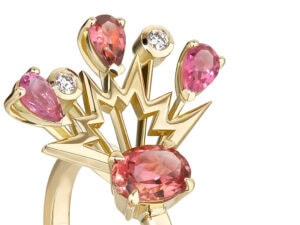Is this for sale? Are you actually waiting for customers to pass through these doors, try this necklace on, and walk out with it?
While contemporary jewelers often invoke the wearer or the collector as end destinations for their creative efforts, this was not always apparent in the crop of exhibitions and projects we visited this year. Some exhibitions had price lists, but not all did. Selling, in those cases, was clearly secondary to showing and finding rewards in the discussion that one’s work could elicit. There is something very endearing about this field’s reluctance to embrace commercialism. It is not “all about money,” and many (if not most) projects presented in Munich ran on untold quantities of voluntary work. Unpaid curators and their unpaid friends set up glorious not-for-sale exhibits in rent-free spaces. This, surely, is cause for rejoicing.
But is it? The other side of the argument is that the professionalization of the field is a necessary step toward being taken seriously by people both in and outside the field. This requires that hard work be rewarded by hard money. We are certainly not advocating that all shows be about selling. But we do think that the field at large, and in particular those makers who moonlight as project managers, cannot afford to dismiss the question as someone else’s problem. Contemporary jewelers are often called to double as project leader, funds raiser, graphic designer, or shipping agent. The frictionless ease with which they do this tends to erase the fact that these are, in fact, separate jobs. When preparing for this second article, we paid attention to the way exhibition projects articulate their relationship to the marketplace—how they cater to both an audience and a clientele; and how participants in a project define their respective roles within it and put a number next to the service they provide or the pieces they show.
Spectator Artist: The Young, The Promising, The Unnecessary
Aaron Patrick Decker
Never having attended, I approached this year’s Schmuck with many lofty ideas in my head. I was under the assumption that Schmuck was a spectator-driven event, one put on for looking, talking, and showing. Those ideas were definitely important but were overshadowed by the overarching sense of a sales-driven market. In retrospect, I felt out of place and impotent in my role as an onlooker. In economical terms, I would be considered a producer of goods, but the idea of Schmuck seems to rely on the consumption of goods. So, I really didn’t have any business being there. I was a spectator of this event, neither an artist showing nor a person really intent on buying. I was a spectator artist.
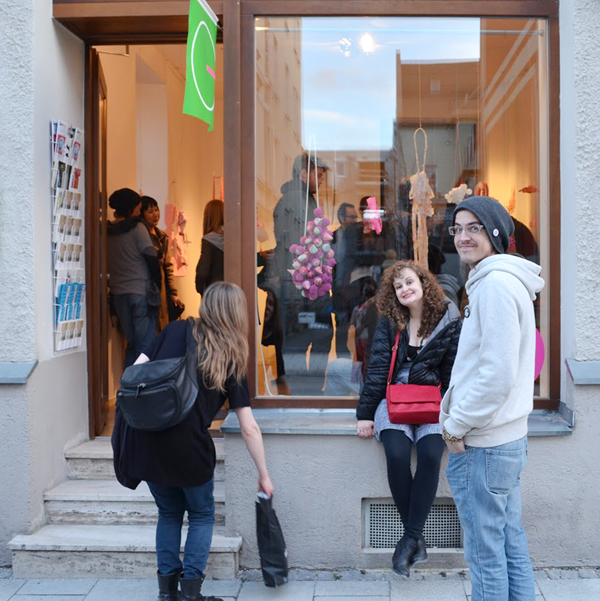
I began to wonder if the artists showing during Schmuck had considered this captive audience’s ability to purchase work. If I was noticing this younger crowd, so were the exhibitors, surely. Like me, they were traveling from show to show, attempting to satiate their appetites for more visual information. But with each exhibition, they grew less and less patient and were hankering for ever stronger aesthetic highs. I don’t believe they were young collectors, but I could be wrong in that assumption.
What I am not wrong in assuming is that the large majority of people attending Schmuck are only there to look, while there existed a small minority of attendees who were actually able to purchase. This unevenness is discouraging to those who hope to sell. I believe it illustrates the disconnect between what the Schmuck fair is meant to do—generate sales—and the purpose it actually serves—inspiring a large crowd of young, bright, and promising art jewelers. (As Sienna Patti of Sienna Gallery put it one night, “There are a lot of makers out there. A LOT.”) How many of us can afford to buy one, let alone several, pieces of contemporary jewelry? And if we are not there to purchase work, what are we, spectator artists, giving the community in return for the inspiration it provides?
I write. I disseminate information I take in at events such as Schmuck, hoping that readers become better informed about the world of art jewelry. I insulate. My practice is insulating. I write to the Art Jewelry Forum audience from the position of an embedded reporter. My objectivity is minimal. This role may seem counterproductive to the economic vibrancy and growth of the art jewelry world. Or, maybe it is my role to present this information to a broader audience, providing people who have little exposure to contemporary jewelry with easily accessible reports on, and insights about, the field. Maybe I am contemporary jewelry’s unofficial PR agent.
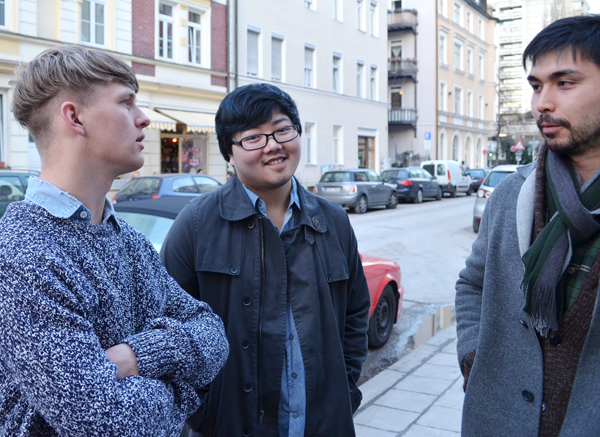
This is something I hope for the future of Schmuck. As an audience of makers, gallerists, and jewelry enthusiasts, it is our job to be a part of Schmuck in more ways than just onlookers. An event like this should require some advance preparation: What am I hoping to achieve during this trip? Which shows are important for me to look at and why? Is there someone I would like to show my work to, and if so, do I need to make contact with him or her a few weeks before the event starts? Do I want to blog about my visit? Let’s plan ahead. If my visit to Munich is basically an inspirational trip, then I should make sure it is a useful, strategic, and well-organized inspirational trip. For their part, exhibitors and gallerists may be well advised to take their younger audience into account and strategize on how to reach them and help them become trendsetters, rather than necessary nuisances.[1]
Do I believe it bad to be a spectator artist? No, absolutely not. Art is a spectator sport. It is important, however, to assess one’s role in their field, market, and economy.
Gallery Strategies during Schmuck
Susan Cummins
Looking at Schmuck with a wide-open lens, I wondered … Who is all this frantic activity aimed at? Collectors? Other artists? Media? Mainstream reporters? Münchners? Are the exhibits meant to sell work or enhance the reputation of the artists? Or both? Was any of it successful? Using Schmuck as a case study that might have implications for the rest of the field, I decided to ask the participating galleries some questions about their intentions and their success as well as the implications of the gallery as a sustainable business model.
Of course, everyone will claim that they want to enhance the reputation of the artists, and of course, they want to make money. But there are only a few galleries that devote themselves to making this happen. Out of roughly 60 presentations during Schmuck 2013, 12 took place in professional galleries. By that, I mean galleries that maintain a year-round space and exhibition schedule meant to promote and sell art jewelry solely or among other media.
Three are professional galleries that sell jewelry from a chosen group of jewelers and maintain a constant space:
- Galerie Marzee
- Galerie Spektrum
- Galerie Biro
Six are run by makers or designers:
- Platina
- Galerie Ra
- Schlegelschmuck
- Galerie Christian Pixis
- Galerie Isabella Hund
- tal 20
Three are galleries that show jewelry as well as other media:
- Maurer-Zilioli Contemporary Arts
- Galerie Wittenbrink (Otto Kunzli is the only jeweler)
- Micheko Galerie (Akiko Kurihara is the only jeweler)
Makers run half of the galleries on this list. This means that people trained as jewelers are running galleries and splitting their time between making and selling. The number of gallerists whose only job is to promote and sell jewelry is small. There are also very few galleries who mix jewelry with other media, such as photography, painting, and ceramics, and many of these only represent one jeweler. Two of the galleries run by dealers exist in Munich, four maker-owned spaces are based there, and two of the galleries showing other media.
What is the business model of the contemporary jewelry gallery? As far as I know, there has never been a survey asking pointed questions about how they function from a financial point of view. So, I decided to ask a sample of the 12 galleries about their selling experiences during Schmuck. Were they successful selling work? What was the price range of the jewelry they were exhibiting? What was the most expensive piece they sold? Do they think that their business model is sustainable?
Most of them said they were successful selling work. But perhaps more telling answers come from the numbers quoted in answer to my other questions. Galerie Wittenbrink, Maurer-Zililoi, and Galerie Marzee were exhibiting with the highest priced pieces, which ranged from €36,000 to €27,000. Among those interviewed, the actual amount for a single piece of jewelry sold topped out at €20,000 with other reports of €9800, €8000, €4000, €3300, €2200, and €500 as the highest sales figures at various locations. The artists fetching the top prices are fairly predictable—Otto Künzli, Manfred Bischoff, Bruno Martinazzi, and Annelies Planteijdt—but surprisingly, one of the younger jewelry graduates from Munich, Akiko Kurihara, placed among the highest priced sales as well.
I got the most complex answers to my questions about the success of the gallery as a sustainable business model. The gallery structure for selling jewelry is based on the art gallery model. It involves representing a certain number of artists, and through diverse methods, exposing these artists’ work to the buying public on a fairly regular basis. The job of the dealer involves promotion in a variety of ways (press releases and ads), scheduling, choosing the right product to sell (getting the right jewelers for the gallery), traveling with your wares to other venues (fairs), educating and catering to buyers (special dinners, arranged studio visits, and other preferred treatment), and often producing catalogues and other texts to establish the credibility of the maker in the eyes of the potential collector. This way of doing business depends on the ability of the gallery to build the reputation of the artist and allow the demand to grow and the prices to rise. This is not a craft shop or design store or a typical retail model. It is an art gallery model.
Virtually every gallery owner I interviewed said that the market was not well developed for art jewelry, and that we had a lot of work to do to make it more sustainable. One of the oldest and most highly respected dealers said that “it isn’t at all profitable,” and that “the high costs of doing business make it hard to keep going.” There was a fair amount of complaining from everyone about the small size of the audience and the aging of the gallery-going population. It is a strongly held belief that the older collectors have slowed down their acquisitions and are now looking for the right museums for their collection. In effect, they have dropped out of the market and are not being replaced by younger buyers or collectors.
The concept of art jewelry as a valuable object has not been developed as well as the dealers would like. Why is this? Some mentioned the failure of contemporary jewelry to find a foothold in auctions. This would test the willingness of the audience to purchase jewelry and establish its value while providing a potential source of liquidity for collectors. Although jewelry wants to play in the art market, the art auction houses can’t sell it. Pierre Bergé was given as an example of an auction house that gave up trying. Calder, both an artist and jeweler, can compete, but so far no one else can, at least in the big art auctions. There are some smaller auction houses where mid-century jewelry occasionally shows up and is sold, but it is rare to see things of a more contemporary vein sold. The importance of the museum’s role in establishing value was also mentioned. Big collections have started to go into museums, but still there are only a handful of museums in the world that are interested. And once they have them, the next question is will they display them in ways that would attract a big audience? Will they produce catalogues?
The two youngest dealers I talked to mentioned marketing strategies. One of them said, “I think that the gallery model where artists just give the work to the gallery to sell belongs to the past. Today, artists spend more time on photos and texts than before. They are marketing themselves and selling their pieces by themselves, and that doesn’t match the old gallery model. I think we need to cooperate more and use new directions of marketing and ways of showing for the best results.” In the US, jewelers have been representing themselves at craft fairs for years, and in fact, have become so good at representing themselves that they compete with the galleries that show them. Jewelers everywhere have also organized pop-up shops and put together many exhibitions like those at Schmuck to help market their work. Of course, the Internet has made it possible for artists to set up their own press and communication as well. But can artists and their galleries simultaneously promote and sell work?[2] Currently, the trend of duplicating exposure raises issues about crossover roles and (possible) market undercutting. Are these efforts effective marketing tools for the long run? The galleries didn’t lay out a grand scheme for cooperation, but then perhaps this is not a field that believes in the grand scheme. Everyone did emphasize the need to explain the jewelry and educate the audiences, however no one has hired a PR firm to help. They just do it on their own.
All of the dealers I interviewed were optimistic despite the unfavorable odds they faced. They believe in the jewelry they are representing and in the intelligence and talent of the people making it. For them, this continues to justify the tremendous effort required to keep a gallery alive.
I wonder if this brand of militant idealism has its roots in the mid-century notion that art is a cause worth suffering for and in our uneasiness with the extreme monetization of contemporary art. In fact, artists, curators, critics, dealers, and auction house executives quoted in a recent Art in America article titled “Creativity and Commerce” were distancing themselves from the purely financial. (They seem to lay the blame on auction houses for stoking the current frenzy for bigger and more spectacular art.) Meanwhile, despite the fact that it does not reach exorbitant hammer prices, the contemporary jewelry field seems even more reluctant than the art world to let go of the worry that they might be selling out by being financially successful. Is there some fear on the part of the dealers to raise the prices on jewelry? Are they too cautious? Certainly, a larger number of people can afford to buy the best of art jewelry rather than of fine art because jewelry is so much less expensive. But I have to wonder why those droves of potential collectors have never found their way to the jewelry galleries? Maybe the jewelry isn’t expensive enough?
In my mind, the art jewelry field is slowly developing a larger audience and a market, but it might look different than the one the art market has formed. The artists will help shape it, as has always been the case, but now there are more tools for them to use. Meanwhile, the prices in the art jewelry market have been rising, but then so have all the costs of doing business. The galleries have to compete in art or design fairs and begin to find new audiences. They are forging paths for others to follow and building a larger audience. And some of them are doing just that, but it is a painfully slow, exhausting, and expensive process.
Show & Sell
Marthe Le Van
Babette von Dohnanyi Volatile Geometria, Saffeel’s
Suspended in Pink, 50 artists, Studio Gabi Green, Curated by Laura Bradshaw-Heap
Students from Maastricht Academy of Fine Arts and Design, Interactive Project, Internationale Handwerksmesse

Change can be mighty unsettling. Just ask anyone involved in publishing in the early twenty-first century. As giant conglomerates swallowed independent publishers and neighborhood bookstores, as Internet retailers and digital books revolutionized product delivery and consumption, maintaining a reliable grasp on how the field works became impossible. As uncertainty became the “new normal,” change had to be embraced rather than feared. Attempts to control turmoil in the industry came from every direction. Remedies to “save the book” were extolled one day and condemned the next, making me wary of false proclamations and one-size-fits-all solutions.
Unlike publishing, the commercial system that supports the flow of money through art jewelry has not yet collapsed into chaos, but it hovers on the brink. Unless the channels for connecting customers with art jewelry are reimagined and multiplied, the field will not grow at an appreciable rate. Even its current fiscal status for maker and for seller may not be sustainable. Rather than speculate on solutions, I prefer to report on actual initiatives undertaken at Schmuck 2013. These include a pop-up shop, a crowdfunding raffle, and an experience without charge. Alone, none of these will transform how money is made in jewelry, but all of them are valid attempts to question, confront, or alter the status quo.
In essence, Schmuck is a collection of pop-up shops instigated to make money and intensify brand excitement. To this end, Schmuck delivered lopsided results. It appears to be the best place on earth to make and strengthen one’s name as a contemporary jeweler, but whether this elevated “brand” recognition was accompanied by financial gain seemed to be of no great concern. Like pop-up shops, most Schmuck exhibits relied on alternative spaces, and most of these venues were vacant rooms. It was clear that much time and effort went into transforming these blank boxes into compelling environments for art, but little energy was applied to preparing the pop-ups for sales.
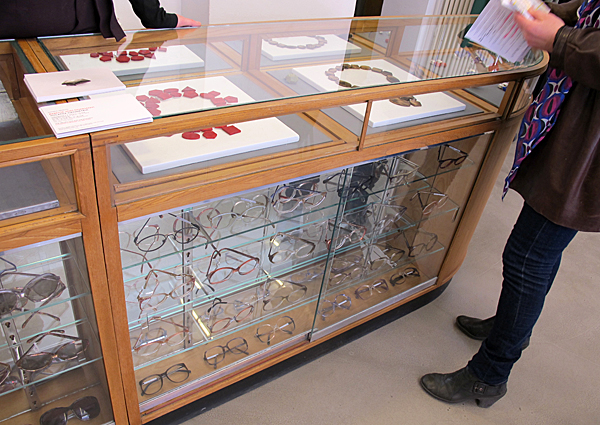
Most Schmuck shows had “sitters” rather than “sellers.” If I had questions, sought prices, or wanted to try something on (gasp!), the onus was on me to identify who was in charge. Sandy Saffeels took the initiative to introduce and clearly identify herself as the conduit to commerce. Babette von Dohnanyi was on hand and brought into a sale as needed, but Sandy took the lead. Selling is a practice. It requires learning and adapting techniques, finding and refining your voice, and continually strengthening it through reflection and repetition, trial and error.
Curator Laura Bradshaw-Heap gambled on an enterprising (some would say brazen, some would say bold) strategy for producing extra income from and for the traveling exhibition Suspended in Pink. The name of each exhibiting jeweler was typed on a paper strip and placed in a hat. In January 2013, during the opening reception at the show’s first venue, one artist’s name was pulled from the hat and sealed in an envelope. For £5, €6, or $8 per guess, attendees could (and still can) wager on whose name is in the envelope in hopes of winning a piece of jewelry from that person. This August, at the final stop for Suspended in Pink, a winning raffle ticket will be drawn. On the exhibition website, Bradshaw-Heap stresses that the money raised through the raffle will be used to pay the jeweler for the prize. Any income earned above the price of the piece (whether this figure is wholesale or retail is not stated) will be reinvested in the exhibition to expand its touring itinerary.
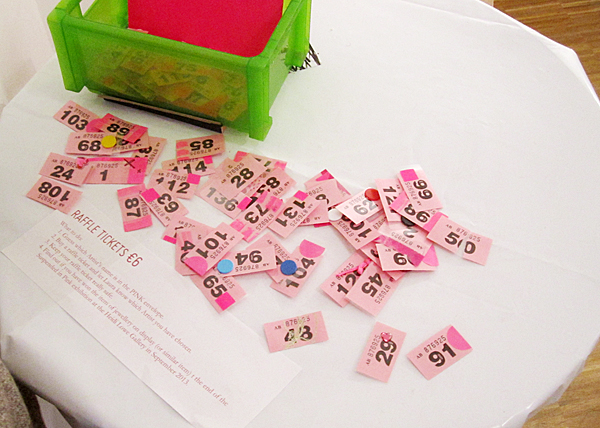
As a shopper, the improbability of winning and the delay of gratification stopped me from trying my luck. If the raffle had been framed as a fundraiser, I would have purchased a ticket (or two or three). The call to action for charity is a quick motivator because it is a familiar, if unfortunate, method to money. But to date, I hadn’t experienced a precedent for crowd-funding an individual’s jewelry acquisition. It felt strange. Was the raffle some sort of benign Ponzi scheme? I was dubious—like when I placed my first book order on Amazon. As a retail storeowner and salesperson, the raffle felt amateurish, gimmicky, and a bit desperate—like when I heard about Facebook for the first time. Ultimately, after reconciling all my perspectives, I believe there is much to applaud in the Suspended in Pink raffle. It feels fresh and innovative, optimistic and courageous, liberating and democratic—all worthy consequences pointing toward progress.

The Maastricht event brought the pure pleasure of interacting with jewelry to life. It was personal, social, and unforgettable. Isn’t this the core of what we traffic? Our commodity is a luxury. It’s superfluous. We will live without it. So what are we really selling? Desire, identity, and experience are three things that come quickly to mind. These sensations are a prerequisite to commerce and enacting ways to stimulate them should be a priority. Academic understanding alone cannot replace a deficit in consumer desire. The longer and harder the contemporary jewelry field tries to use education as our primary path to sales, the deeper the hole we dig for ourselves.
Attempts to escape the hole we’ve dug by piggybacking contemporary jewelry onto an established business model persist. “As soon as the __________ world (art, fashion, design, etc.) acknowledges us, we’ll be saved!” Actions based on this premise—which I freely admit to having taken part in—have been largely ineffective. They feel parasitic, degrading, and a tad lazy. Contemporary jewelry needn’t cling to any coattails. We must, however, become responsible for envisioning and enacting opportunities for commerce, and there is no time like the present to be groundbreaking.
Show and Tell
Benjamin Lignel
Bucks ‘n Barter, Katrin Spranger, Nicolas Cheng, Friederike Daumiller, Beatrice Brovia, Hilde De Decker, Richard Elenbaas, Tzu-Ling Lee, Prang Lerttaweewit, Galerie Kullukcu
Pseudomorphic Projections, Reframed Wonderwall & Reverend RT Ampee’s Pillow Pictures and Erotic Insignia, Peter Vermandere, Atelier von Gierke-Berr
Fallmamal-Umsturz erwunscht. Nine Jewelers at the Bowling Alley, Sungho Cho, Anja Eichler, Beate Eismann, Julia Heineccius, Young-Hee Hong, Wolfgang Löffler, Barbara Schrobenhauser, Gabi Veit, Manuel Vilhena, Theresa Restaurant
(Ig)noble, Hanna Liljenberg, Pernilla Persson, Sanna Svedestedt, Karin Roy Andersson, Lisa Björke, Schwedische kirche (Swedish church)
No show dealt more directly with the question of value than Bucks ‘n Barter. The work selected engaged with trade, value (its speculative rise and entropic fall), and the various proxies that stand for money spent or hoarded—banknotes, receipts, precious metals, and wallets. Bucks ‘n Barter is also one of a handful of collective shows presented in Munich that was actually curated. By this I mean that the planned encounter, in one room, of specific work by specific artists created something different (and in this case, more rewarding) than the sum of its isolated parts. Curating calls for a curatorial brief to be articulated, carried through in a selection process, and translated into a convincing installation, with possibly—but here I realize I am pushing it—some mediation when applicable.
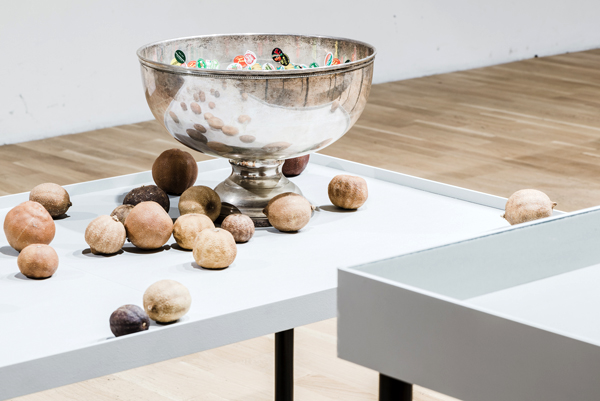
Bucks ‘n Barter ticked all those boxes, and more. The “more” took the form of a culinary performance on the opening night, meant to stimulate conviviality and transform the walk-up gallery space into a “contemporary caravanserai,” according to their press release. What it did not provide on the three occasions one of the AJF reporting team asked for it was a price list. This was a show about money that did not address its own market value or want to exist as a commercial proposition. I [initially] attributed this glaring omission to a problem of conceptual ambition. The four curators, possibly concerned that a pricelist—i.e. an invitation to consider these artistic propositions as commodities—might undermine their critical impact, missed an opportunity to add a layer of complexity to their project. Visitors were, in fact, shielded from whatever could turn them into potential buyers. During the day, and even more so at night when they were offered food, they were treated as guests. The drinks were “on” the artists, but also, presumably, on the various sponsors of the project who were listed in the very detailed press release.
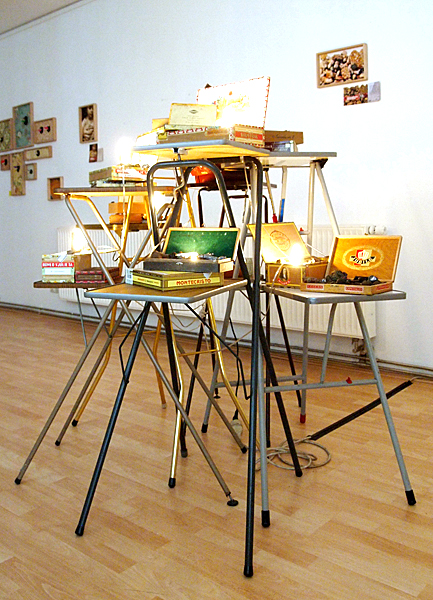
Peter Vermandere, for the second year in a row, exhibited several bodies of work under made-up patronyms. As usual, his multi-layered presentation was feverishly accumulative and anchored itself in both archeological and fictional origins. The result concertinaed over several mineral eons and flip-charted medieval references and matchbox trivia. Less tightly curated than Bucks n Barter, it still had the density of a group show.
It turned out Vermandere had a price list somewhere that could be accessed, one surmises, if absolutely required. “I don’t want to communicate prices,” Vermandere helpfully explained, “a transaction would get in the way of conversation.” Vermandere primarily sees Munich as a personal challenge—“You have to be here if you want to reach a certain standard. It forces me to get better at what I do.” Secondly, he sees it as a networking opportunity—“This is not a market in the financial sense. What is exchanged are ideas and contacts.” If not through sales, I asked, how does he evaluate how well he did? “Success is opening the door at 11:00am on the first day.” (Price range: 125 to 5950 euro; average: 300 to 400 euro.)
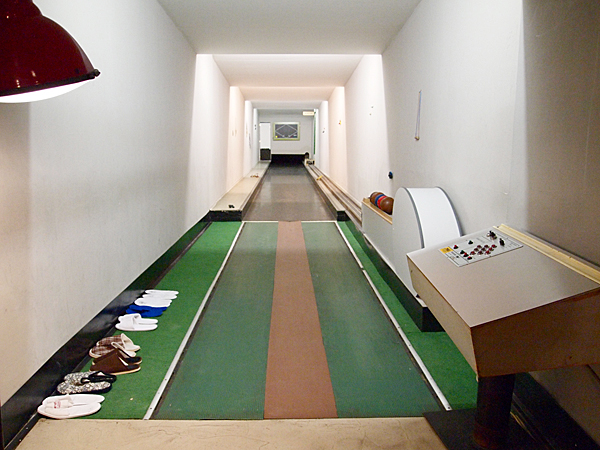
The two artists, who also participate in the show, cast a wide net to assemble their roster of exhibitors. Established names and young graduates from Europe and the US make up their selection. In the minds of the curators, two years of work and a very appetizing show did not seem to require payment from the participants. Not even a commission on sales? Not even. (Price range: 240 to 2100 euro; average: 800 euro; 5 unpriced pieces)
Talking to Eichler, Veid, Vermandere, and Katrin Spanger from Bucks ‘n Barter, one senses that the challenge of putting together an exhibition was reward in itself, and that permission to organize and participate in a show trumped any form of financial entitlement. Several factors may explain this. First, the general (and much broadcasted) perception that the contemporary jewelry field cannot afford to acknowledge, much less finance, the several ancillary jobs that grease the axle of its snail-paced progress, such as curation, mediation, promotion, and sales. Second, a cultural resistance on the part of people trained to respect skills to claim compensation for a curatorial role that is not theirs by training. And finally, when the curators double as exhibitors, the widely accepted notion that by helping others they are helping themselves.
Paradoxically, the unpaid curators I talked to were invariably grateful for the trust placed in them by either participating artists or the institutions for which they moonlighted. Presumably, the experience thus gained would provide them with the credentials to mount … more unpaid shows?
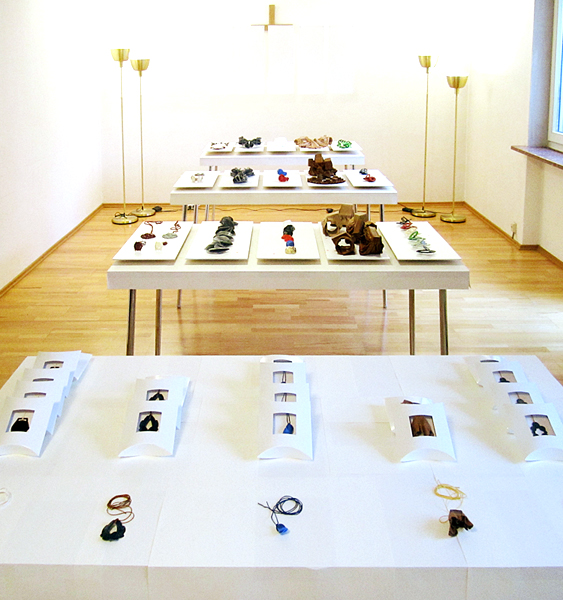
Meanwhile, pegging value on actual labor time rather than the more arbitrary notion of artistic merit ran counter to the community-wide effort to disengage the price of contemporary jewelry from a computable standard (i.e. time or gold), and bestow art market volatility on it. The show worked because the question of sales was built into the exhibition brief and gave an absurdist answer to the question “how much is it worth?”
The examples discussed here paint a rather black-and-white picture of the contemporary jewelry market, with seemingly not-for-profit activities at one end of the spectrum and very self-consciously commercial ventures at the other. (Bling-sploitation?) I chose them for contrast, knowing that there are several shades of green between the two. That they can coexist so easily has to do with the fact that this market sees exposure and money as equally powerful currencies and has not quite managed yet to put a price on the former.
[1] If this fact was not clear enough to begin with, it was made apparent when attending an opening where 12 “younger” artists and I were shooed out of a venue. The gallerists had an impromptu showing of the work to “special customers” as they put it. The click of the lock upon our exit sent everyone a message about their worth as a customer.
[2] This subject is discussed at length in the current “In Sight” series titled “High Expectations: Artists, Galleries, and their Relationship(s)”.



